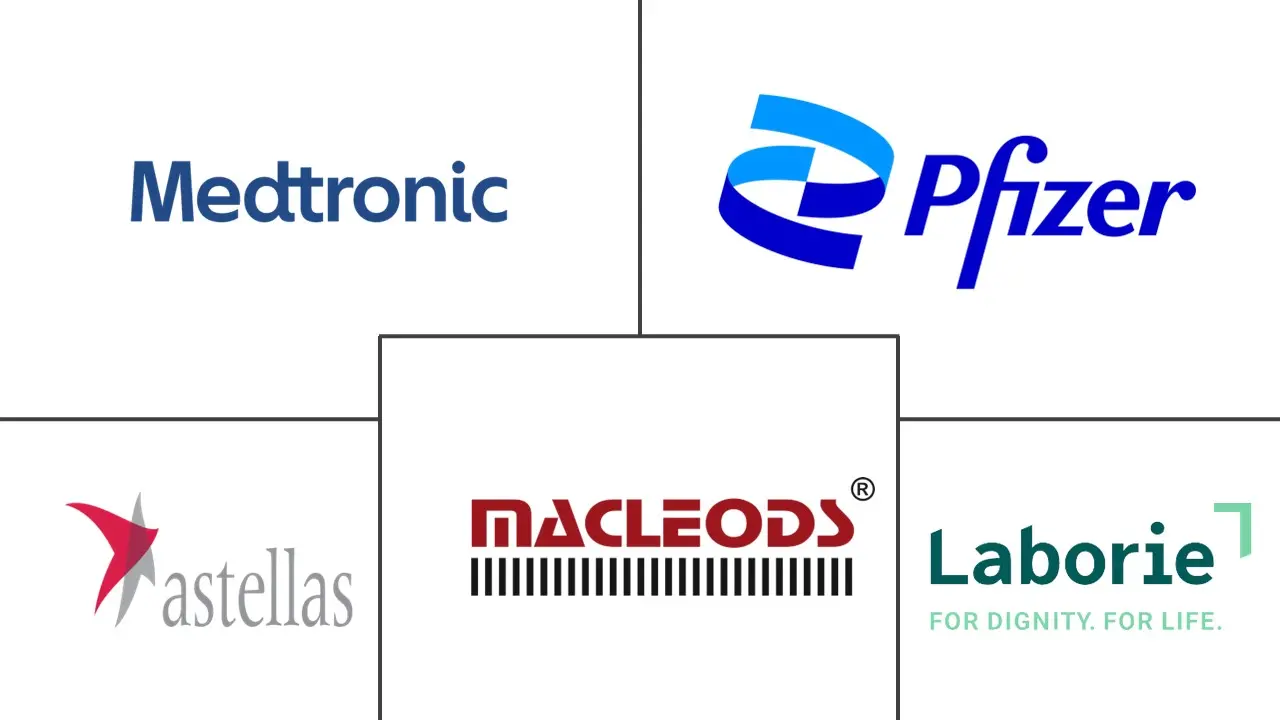Overactive Bladder Treatment Market Size and Share
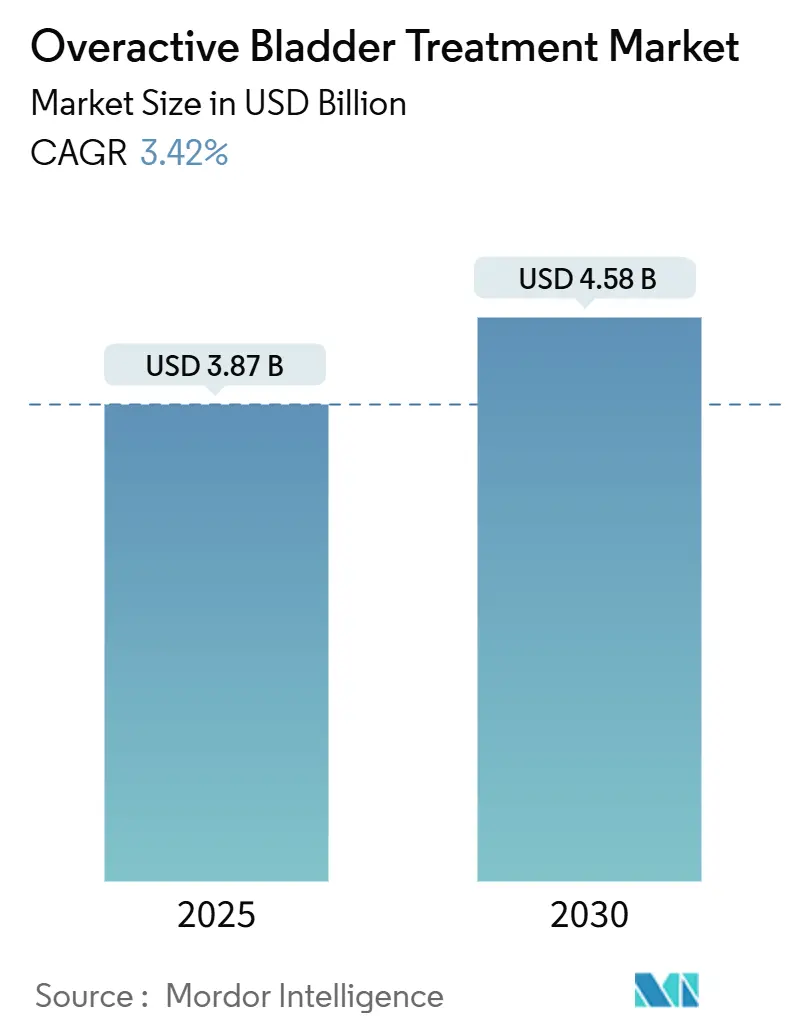
Overactive Bladder Treatment Market Analysis by Mordor Intelligence
The overactive bladder treatment market was valued at USD 3.87 billion in 2025 and is forecast to reach USD 4.58 billion by 2030, advancing at a 3.42% CAGR. Demand is sustained by population aging, the clinical shift toward β3-adrenergic agonists, and expanding device‐based options. Anticholinergics still provide scale advantages but face cognitive‐safety headwinds that accelerate prescribing changes. β3-agonists gain share on the back of new approvals, while reimbursement expansion for neuromodulation and botulinum toxin widens access to third-line care. Digital diagnostics further broaden reach, especially in regions with urologist shortages, and corporate consolidation is reshaping competitive dynamics in both pharma and devices.
Key Report Takeaways
- By therapy class, anticholinergics led with 44.35% of overactive bladder treatment market share in 2024, whereas β3-agonists are projected to grow at 8.25% CAGR through 2030.
- By disease type, idiopathic cases generated 75.53% of 2024 revenue, while neurogenic cases are expanding at a 6.85% CAGR to 2030.
- By geography, North America commanded 38.82% revenue in 2024; Asia-Pacific is set to post the fastest 7.81% CAGR through 2030.
- By route of administration, oral therapies accounted for 65.62% of the 2024 overactive bladder treatment market size, while implantable devices are poised for a 9.52% CAGR.
- By end user, hospitals captured 53.82% revenue in 2024; homecare and telehealth services are advancing at 9.61% CAGR.
Global Overactive Bladder Treatment Market Trends and Insights
Drivers Impact Analysis
| Driver | (~) % Impact on CAGR Forecast | Geographic Relevance | Impact Timeline |
|---|---|---|---|
| Aging Population & Rising Prevalence Of Urinary Disorders | +1.2% | Global, concentrated in North America & Europe | Long term (≥ 4 years) |
| Adoption Of β3-Adrenergic Agonists With Favorable Cognition Profile | +0.8% | North America & EU, expanding to Asia-Pacific | Medium term (2-4 years) |
| Expanding Reimbursement For Neuromodulation & Botox In Asia | +0.6% | Asia-Pacific core, spill-over to MEA | Medium term (2-4 years) |
| Growth In Tele-Urology & Digital Diagnostics | +0.4% | Global, early gains in North America | Short term (≤ 2 years) |
| AI-Assisted Discovery Accelerating Novel Small-Molecule Pipeline | +0.3% | Global, R&D centers in US & EU | Long term (≥ 4 years) |
| Clinical Validation Of Plant-Derived Anti-Muscarinic Compounds | +0.2% | Asia-Pacific, traditional medicine regions | Long term (≥ 4 years) |
| Source: Mordor Intelligence | |||
Aging Population & Rising Prevalence of Urinary Disorders
People aged 65 years and older experience overactive bladder prevalence above 30%, compared with 16-18% in general adult cohorts. In Japan, roughly 12.4 million adults require symptom management, prompting payers to prioritize cost-effective care models. Similar demographic shifts in China, South Korea, and European countries enlarge the overactive bladder treatment market while encouraging health-system investment in urological capacity. As national insurance schemes expand to cover continence services, demand for pharmacologic and device-based therapies rises across all economic strata.
Adoption of β3-Adrenergic Agonists With Favorable Cognition Profile
Long-term studies link oxybutynin to a 12% higher dementia risk in women older than 65, accelerating clinician pivot toward β3-agonists. A 1.49-million-participant Japanese cohort confirmed lower cognitive risk with mirabegron and vibegron. The December 2024 FDA approval of vibegron for men with benign prostatic hyperplasia-related symptoms opens a new addressable population and reinforces the safety narrative.
Expanding Reimbursement for Neuromodulation & Botulinum Toxin in Asia
Taiwan and South Korea recently broadened coverage criteria, elevating mirabegron adherence to 68.5% versus 60.4% for antimuscarinics[1]J. Chen et al., “Treatment Patterns With Mirabegron and Antimuscarinics for Overactive Bladder,” link.springer.com. Medicare’s structured pathway in the United States—requiring conservative failure before 100-unit botulinum toxin dosing—serves as a template for Asian payers. These moves increase device penetration and stimulate regional supplier investment.
Growth in Tele-Urology & Digital Diagnostics
AI algorithms now deliver 97% concordance with manual bladder scans and 100% specificity for elevated post-void residuals. Remote monitoring platforms bridge specialist gaps in rural zones, reduce appointment backlogs, and sustain therapy adherence among older adults. Precision-based dosing adjustments via telehealth improve outcomes and trim hospital visits, expanding the overactive bladder treatment market without proportionate infrastructure costs.
Restraints Impact Analysis
| Restraint | (~) % Impact on CAGR Forecast | Geographic Relevance | Impact Timeline |
|---|---|---|---|
| Cognitive Safety Concerns Of Chronic Anticholinergic Use | -0.9% | Global, acute in aging populations | Medium term (2-4 years) |
| Patent Cliffs For Leading Antimuscarinics Dampening R&D Spend | -0.7% | Global, concentrated in developed markets | Short term (≤ 2 years) |
| Limited Urologist Density In Low-Income Regions | -0.5% | Sub-Saharan Africa, rural Asia, Latin America | Long term (≥ 4 years) |
| Fragmented Payer Coverage For β3-Agonists In US & EU | -0.4% | North America & EU, insurance-dependent | Medium term (2-4 years) |
| Source: Mordor Intelligence | |||
Cognitive Safety Concerns of Chronic Anticholinergic Use
A Korean national cohort revealed increased dementia incidence with anticholinergics versus β3-agonists, triggering formulary re-ranking across insurance plans. U.S. Medicare now favors cognitive-sparing options, constraining legacy drug volumes while directing investment toward novel mechanisms. Clinicians adopt shared-decision tools that weigh symptom relief against cognitive risk, slowing anticholinergic unit sales.
Patent Cliffs for Leading Antimuscarinics Dampening R&D Spend
Generic erosion has cut cash flows for first-generation molecules, leading Sumitomo Pharma to reduce its U.S. workforce by 400 employees in 2024[2]Sumitomo Pharma Co., “Reduction of Workforce and Other Rationalization Measures,” sumitomo-pharma.com. Budget reallocation toward β3-agonists and combination regimens leaves fewer resources for incremental anticholinergic innovation, narrowing the near-term development slate and affecting overactive bladder treatment industry pipelines.
Segment Analysis
By Therapy: β3-Agonists Challenge Anticholinergic Dominance
The overactive bladder treatment market size for anticholinergics reached USD 1.71 billion in 2024, equal to 44.35% of total revenue. Cost advantage and guideline familiarity sustain their lead, yet mounting cognitive concerns restrain growth. β3-agonists captured 22.9% in 2024 and are forecast to expand at an 8.25% CAGR, outpacing all other modalities. Vibegron’s new indication for men with benign prostatic hyperplasia underpins this surge, while mirabegron’s long-term data reinforce safety perceptions. Botulinum toxin retains niche status but boasts 74.5% complete pad discontinuation over 15 years, attracting refractory cases. Boston Scientific’s 2024 purchase of Axonics intensifies competition in sacral neuromodulation, promising next-generation lead technology and rechargeable IPGs that lengthen device life cycles.
Clinical practice increasingly trials hybrid protocols—such as duloxetine-tolterodine—returning 77.4% patient satisfaction in mixed incontinence cohorts. Plant-derived candidates, including rhynchophylline, enter exploratory trials focused on M3 receptor modulation, adding a low-cost innovation layer. As patent cliffs depress traditional R&D spend, alliances between digital diagnostic firms and pharma players accelerate patient identification, amplifying therapy uptake across the overactive bladder treatment market.
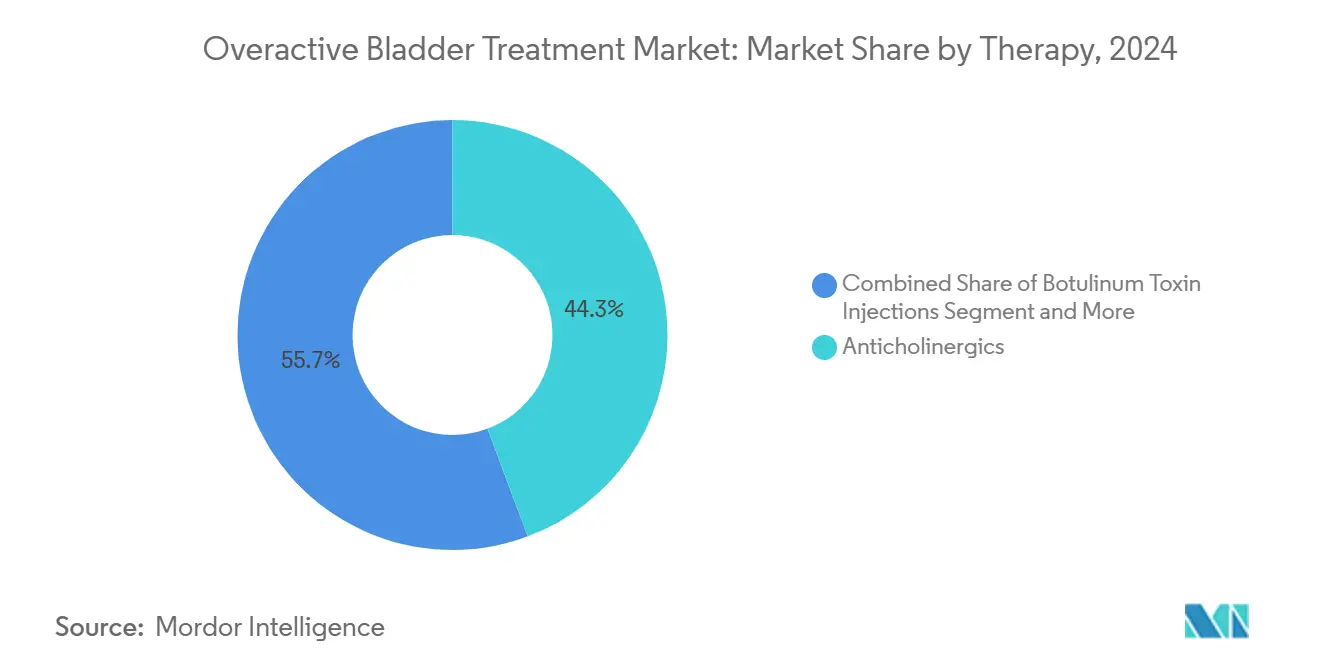
Note: Segment shares of all individual segments available upon report purchase
By Disease Type: Neurogenic Cases Drive Disproportionate Growth
Idiopathic presentations generated USD 2.94 billion in 2024, translating to a 75.53% share within the overactive bladder treatment market. Streamlined work-ups and primary-care familiarity underpin consistent demand. Neurogenic cases, valued at USD 0.95 billion in 2024, will grow 6.85% annually through 2030, fueled by heightened surveillance in spinal cord injury, Parkinson’s disease, and multiple sclerosis populations. Ultrasound-guided botulinum toxin injections reduce procedural risks, broadening provider adoption. Premium pricing for device-based regimens and complex pharmacologic formulations offsets smaller volumes, lifting revenue per patient and improving manufacturer margins.
Policy makers note that aggressive neurogenic management curbs urinary tract infections and renal complications, generating downstream savings. These economic arguments help justify payer coverage for high-ticket interventions such as sacral and tibial nerve stimulation, fortifying the neurogenic revenue pool in the overactive bladder treatment market.
By Route of Administration: Device Innovation Challenges Oral Dominance
Oral agents generated USD 2.54 billion in 2024, controlling 65.62% of the overactive bladder treatment market size. Once-daily β3-agonists reinforce adherence, and widespread generic anticholinergics keep entry costs low in developing health systems. Nevertheless, implantable neuromodulation devices are set for a 9.52% CAGR, aided by single-incision techniques and improved MRI compatibility. Boston Scientific’s USD 3.7 billion Axonics acquisition consolidates engineering talent, potentially shortening product cycles. Transdermal patches supply a non-invasive alternative for patients with swallowing difficulties, though pricing still limits uptake.
Botulinum toxin remains injection-based yet enjoys expanding reimbursement and streamlined prior authorization protocols. Together, minimally invasive devices and injectables chip away at oral primacy, diversifying revenue sources across the overactive bladder treatment market.
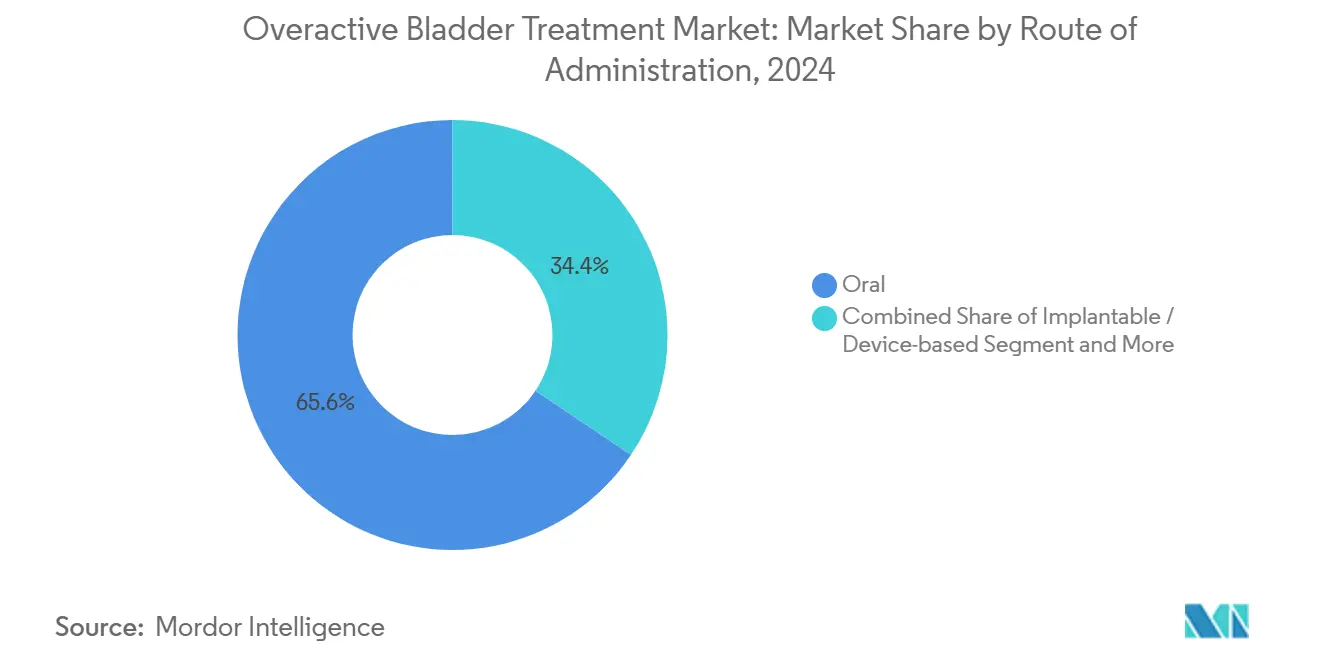
Note: Segment shares of all individual segments available upon report purchase
By End User: Homecare Adoption Accelerates Through Digital Health
Hospitals delivered 53.82% of 2024 sales, reflecting concentration of invasive procedures and complex diagnostics. Specialist centers with full urodynamic labs facilitate accurate subtype stratification and immediate therapy initiation. Tele-urology has emerged as a viable extension, leveraging AI ultrasound to transmit bladder metrics with 97% accuracy to remote clinicians. Home-based adherence apps remind patients to take β3-agonists and track symptom diaries, elevating persistence rates.
Homecare and virtual platforms are forecast to post a 9.61% CAGR, supported by payer incentives that counter costly emergency admissions for incontinence-related falls. Specialty clinics bridge the gap by offering tailored sessions for pelvic-floor training and on-site botulinum toxin injections, expanding choice within the overactive bladder treatment industry’s delivery ecosystem.
Geography Analysis
North America produced USD 1.50 billion in 2024, equivalent to 38.82% of the overactive bladder treatment market. Robust insurance coverage and early uptake of β3-agonists sustain revenue, while Medicare’s clear algorithms for neuromodulation keep device channels healthy[3]Centers for Medicare & Medicaid Services, “Proposed LCD – Botulinum Toxin Injections,” cms.gov. Hospital system consolidation encourages formulary leverage, ensuring rapid deployment of new cognitive-sparing molecules once licensed.
Europe contributed USD 1.13 billion in 2024, buttressed by the July 2024 pan-EU authorization for vibegron. Harmonized labeling streamlines launch costs and unifies pharmacovigilance reporting. National health services, particularly in Germany and the Nordics, pilot bundled payments that reward longitudinal symptom control, benefiting device makers.
Asia-Pacific, valued at USD 0.87 billion in 2024, is on track for a 7.81% CAGR to 2030, the fastest expansion among all regions. Japan’s advanced aging profile and clinical trial infrastructure elevate guideline compliance, while Taiwan and South Korea report 68.5% persistence on mirabegron versus 60.4% for antimuscarinics. China and India ramp diagnostic capacity through public-private partnerships, framing overactive bladder as a treatable disorder rather than a normal aging outcome. Improved device reimbursement and local manufacturing hubs shrink acquisition costs, deepening penetration of neuromodulation platforms within the overactive bladder treatment market.
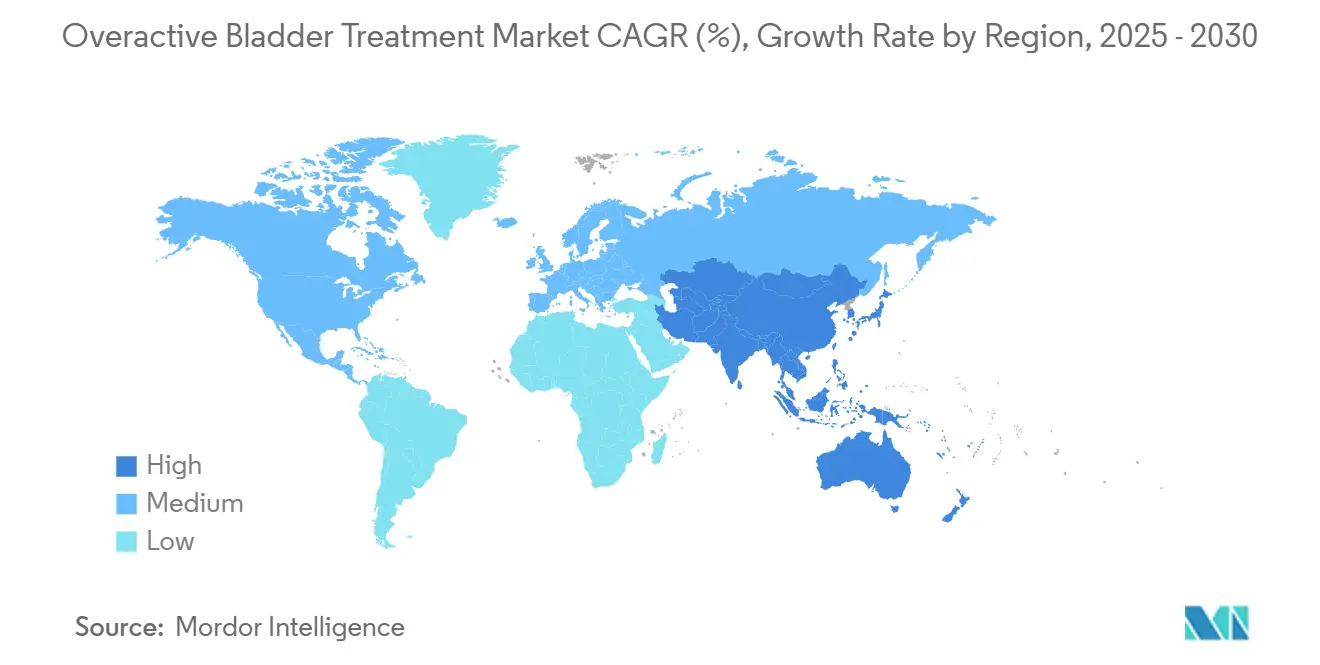
Competitive Landscape
Boston Scientific closed its USD 3.7 billion purchase of Axonics in November 2024, forging a neuromodulation powerhouse and igniting patent clashes with Medtronic over MRI-safe components. The alignment of sacral and tibial stimulation assets under one roof grants Boston Scientific broad procedural coverage, pressuring smaller entrants to locate untapped niches such as closed-loop systems.
Pharmaceutical competition pivots on cognitive safety. Sumitomo Pharma centers growth plans on vibegron, even as generic erosion in other franchises prompts workforce reductions. U.S. and EU payers respond by reevaluating formulary tiers: plans uplift β3-agonists and restrict high-risk anticholinergics to second-line status, swaying prescription patterns across the overactive bladder treatment market.
Venture funding favors convergence themes: Amber Therapeutics raised USD 100 million for adaptive neuromodulation that syncs device output with real-time bladder signals, and multiple AI firms partner with pharma to accelerate molecule discovery. Competition therefore hinges on an integrated proposition—safe drug, smart device, and data-driven follow-up—rather than isolated product advantages, reshaping standard-of-care pathways throughout the overactive bladder treatment industry.
Overactive Bladder Treatment Industry Leaders
-
Medtronic PLC
-
Astellas Pharma, Inc.
-
Macleods Pharmaceuticals Ltd
-
Pfizer, Inc
-
AbbVie Ltd.
- *Disclaimer: Major Players sorted in no particular order
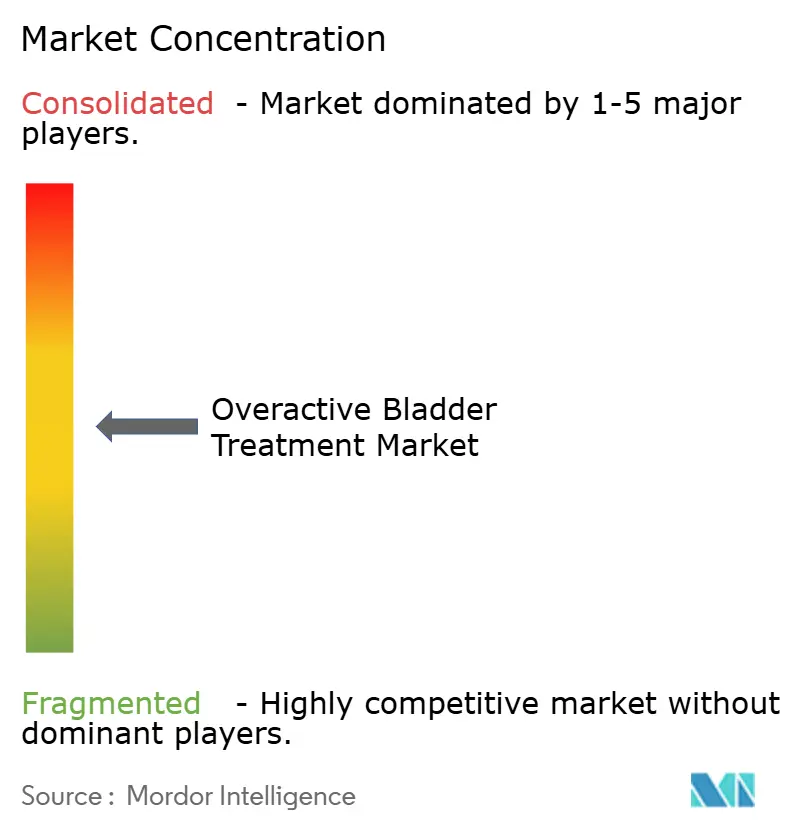
Recent Industry Developments
- December 2024: FDA approved Gemtesa (vibegron) for men with overactive bladder symptoms undergoing benign prostatic hyperplasia therapy, the first β3-agonist cleared for this population.
- June 2024: European Commission granted Obgemsa (vibegron) centralized marketing authorization, enabling simultaneous launch across all EU member states.
Research Methodology Framework and Report Scope
Market Definitions and Key Coverage
Our study defines the overactive bladder (OAB) treatment market as all pharmacologic agents, device-based neuromodulation systems, and botulinum toxin injections that clinicians use to reduce urgency, frequency, and urge incontinence in adults diagnosed with idiopathic or neurogenic OAB.
Scope exclusion: purely absorbent hygiene products and general urinary incontinence pads are kept outside the valuation to avoid double counting.
Segmentation Overview
- By Therapy
- Anticholinergics
- Beta-3-Adrenergic Agonists
- Botulinum Toxin Injections
- Neuromodulation & Sacral Stimulation
- Intravesical Instillation
- Combination Therapy
- Herbal & Nutraceuticals
- Other Emerging Therapies
- By Disease Type
- Idiopathic Overactive Bladder
- Neurogenic Overactive Bladder
- By Route of Administration
- Oral
- Transdermal
- Injectable
- Implantable / Device-based
- By End User
- Hospitals
- Specialty Clinics & Urology Centers
- Homecare & Telehealth
- Geography
- North America
- United States
- Canada
- Mexico
- Europe
- Germany
- United Kingdom
- France
- Italy
- Spain
- Rest of Europe
- Asia-Pacific
- China
- Japan
- India
- South Korea
- Australia
- Rest of Asia-Pacific
- Middle East and Africa
- GCC
- South Africa
- Rest of Middle East and Africa
- South America
- Brazil
- Argentina
- Rest of South America
- North America
Detailed Research Methodology and Data Validation
Primary Research
Mordor analysts then interviewed urologists, pelvic health nurses, hospital pharmacists, and neuromodulation distributors across North America, Europe, and Asia Pacific. Their insights clarified real-world drug discontinuation rates, average device pricing, and emerging beta3-agonist adoption patterns, allowing us to tighten desk-based estimates.
Desk Research
We began with publicly available clinical guidelines and prevalence datasets from bodies such as the International Continence Society, the World Health Organization, Eurostat, and the US CDC, which indicate rising OAB incidence in populations aged forty and above. Cost and prescription trends were captured from FDA drug approval files, Medicare Part D dashboards, and peer-reviewed journals like the Journal of Urology. Company 10-Ks and investor decks enriched pricing and market-share assumptions, while paid platforms including D&B Hoovers and Dow Jones Factiva supplied revenue splits for leading suppliers. This list is indicative; many further databases and trade registries supported secondary validation.
Market-Sizing & Forecasting
Top-down patient pool modeling starts with country-level adult population, OAB prevalence, diagnosis, and treatment penetration ratios, which are then multiplied by weighted average drug or device cost. Supplier roll-ups and sampled ASP × volume checks offer a selective bottom-up cross-check before totals are finalized. Key variables include aging-cohort growth, neurologic disorder incidence, payer reimbursement coverage, brand-to-generic erosion timelines, and neuromodulation implant rates. Forecasts are generated through multivariate regression supported by ARIMA overlays, so we can stress-test scenarios against shifts in prevalence or pricing. Gaps in bottom-up evidence are bridged using median regional benchmarks validated by the expert panel.
Data Validation & Update Cycle
Outputs pass a two-step analyst peer review, variance thresholds trigger re-contacts, and models refresh every twelve months, with mid-cycle updates when material regulatory or M&A events occur.
Why Mordor's Overactive Bladder Treatment Baseline Commands Reliability
Published estimates diverge because firms pick different scopes, cost assumptions, and refresh cadences, so headline numbers rarely align.
Key gap drivers stem from whether home-use pads are included, how aggressively future beta3-agonist uptake is projected, and the currency conversion year that underpins revenue totals. Some publishers rely on static historical averages or exclude device-based therapy sales, whereas our team folds in verified neuromodulation revenue and adjusts for generic price erosion, giving decision-makers a steadier base.
Benchmark comparison
| Market Size | Anonymized source | Primary gap driver |
|---|---|---|
| USD 3.87 B (2025) | Mordor Intelligence | - |
| USD 3.79 B (2023) | Global Consultancy A | Omits sacral and tibial nerve stimulation revenue |
| USD 3.50 B (2022) | Industry Journal B | Uses fixed 2019 ASPs, no currency inflation adjustment |
| USD 3.78 B (2024) | Regional Consultancy C | Applies uniform treatment-seeking rate, ignores country reimbursement variation |
Taken together, the comparison shows that Mordor's disciplined variable selection, annual refresh, and dual-track validation deliver a balanced baseline that clients can trace back to clear epidemiologic and commercial fundamentals.
Key Questions Answered in the Report
What is the current size of the global overactive bladder treatment market and how fast is it growing?
The market was valued at USD 3.87 billion in 2025 and is projected to reach USD 4.58 billion by 2030, advancing at a 3.42% CAGR.
Which therapy class is expanding the fastest?
Β3-adrenergic agonists are the fastest-growing class, expected to post an 8.25% CAGR through 2030 due to their favorable cognitive safety profile and new indication approvals.
Where is regional growth most pronounced?
Asia-Pacific is forecast to achieve the quickest expansion at a 7.81% CAGR, driven by aging populations, broader reimbursement, and improving healthcare infrastructure.
How are device-based treatments impacting the market?
Implantable neuromodulation systems and other devices are projected to grow at a 9.52% CAGR, challenging oral therapy dominance and attracting investment after major acquisitions.
What key factor is reshaping prescribing patterns for anticholinergics?
Large-scale studies linking chronic anticholinergic use to increased dementia risk are shifting clinicians toward cognitive-sparing alternatives such as β3-agonists.
Page last updated on:
